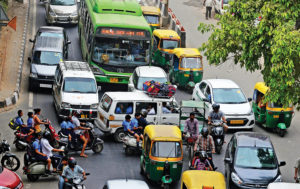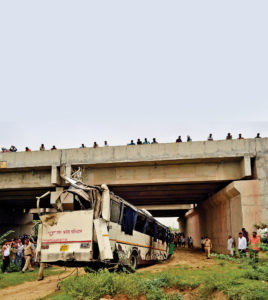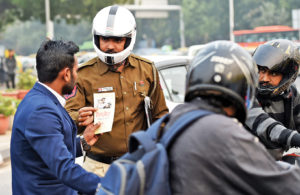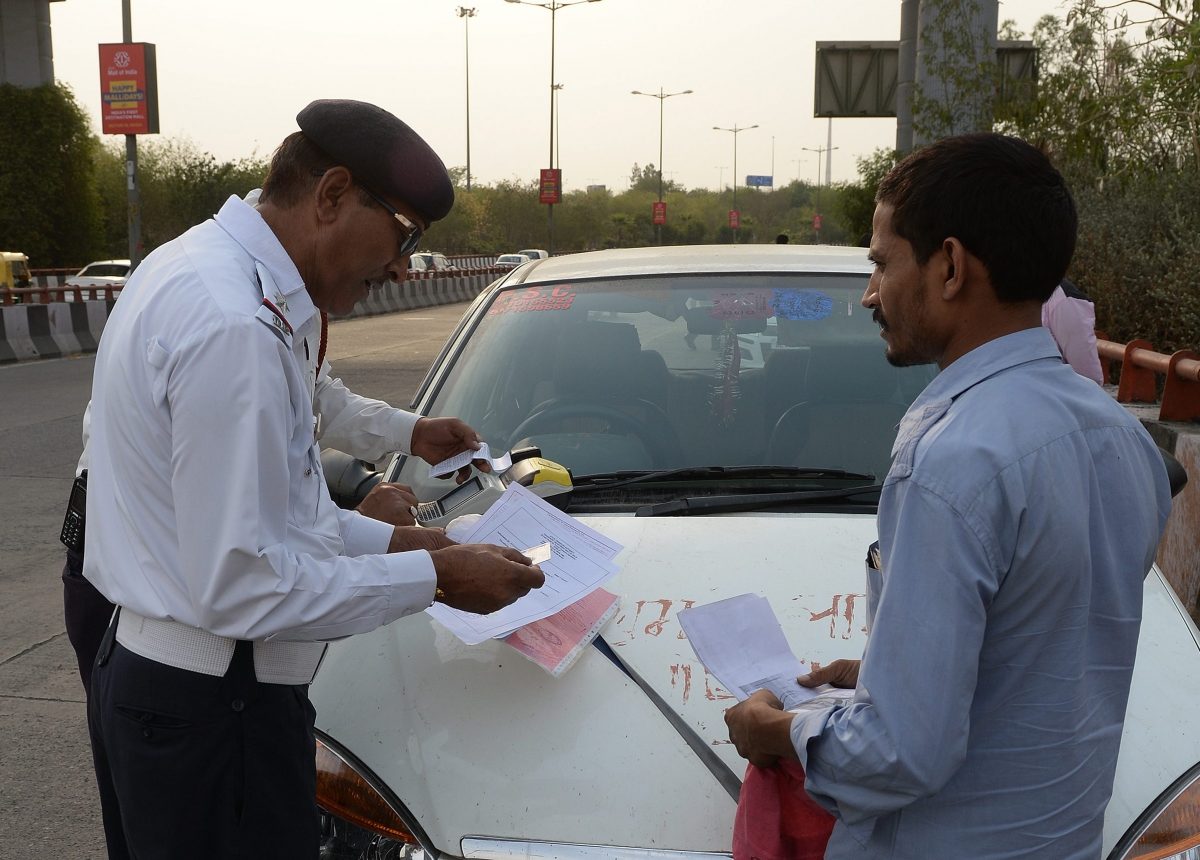The amended Motor Vehicle Act that imposes hefty fines of traffic violators is an absolute necessity in Delhi. But infrastructure in the form of proper signages, smooth roads, functional street lights and correctly designed zebra crossings must also be put in place
On June 2, 5:30 in the morning, like every Sunday, 86-year-old Jasmeet Singh (name changed) was on his way to the nearby gurdwara in Ghaziabad. Only 2 km from his home, he was cycling when a bus rammed into him at high speed from behind. Thrown off the cycle, he hit his head on the road and was rushed to the hospital. Struggling for his life for 11 days, he passed away due to internal bleeding.
According to bystanders, the bus was speeding, and the driver had absconded.
There have been numerous such instances of accidents in Delhi in the past. According to Delhi Traffic Police data, in 2018 alone 1,690 people were killed in road accidents, which means that every six hours a person lost his life in a road accident. The Delhi Police data also shows that almost 50% of these accidents have been caused by people who have been violating traffic norms.
One reason for such carelessness on the road was that the fine imposed on such offences under the Motor Vehicles Act was quite minimal. The fines ranged from rates as low as Rs 100 to the highest at Rs 1,000. For instance, an offence as grave as speeding, which contributes to 35% of the total number of accidents in Delhi, would only set the driver back by Rs 500.

In spite of such low amounts, Delhi Police collected Rs 106 crore worth of traffic fines last year from 11.5 lakh challans issued, a number which has increased by Rs 43 crore in the last three years. So, it is not hard to imagine the amount of nuisance that traffic violations cause in the city.
But now offenders have a reason to worry. The Centre on September 1 passed a resolution for the amendment of the Motor Vehicles Act, wherein all offenders guilty of committing any sort of traffic offence, will be charged hefty fines, sometimes even 10 times the previous fine.
For example, the offence of not wearing a seat belt or helmet, which earlier invited a Rs 100 fine, would now be charged Rs 1,000. Incidentally, over 6 lakh drivers were challaned for not wearing a seat belt last year, the most for any offence in Delhi.
A driver who is not carrying documents like licence, RC, insurance and Pollution Under Control certificate, will now have to pay Rs 5,000 for every document that he does not possess.

Previously, the Act had no separate provision for traffic offences by juveniles — which accounted for 1,228 cases last year in Delhi. Now, the guardian has to pay Rs 25,000 and can even face jail terms upto three years.
Union Road and Transport Minister Nitin Gadkari said that the amendment on to the Motor Vehicle Act was done in ‘public interest’ to prevent deaths by road accidents that have been on the rise in India. “It is to make people aware and create respect for the law”, he added.
Singh’s granddaughter is pleased with the amended Motor Vehicle Act. “As a person who has lost a family member because of rash driving on the road, I think this was a much-needed move to prevent further accidents from taking place,” she adds
But has this had any impact on the roads of Delhi, ever since its implementation on September 1?
Traffic constable Harish Kumar (name changed), who is posted at one of the traffic signals near Red Fort — a traffic violation hotspot in the city — feels that strict implementation has made a big difference.
“Earlier, I would see many bikers on the roads without helmets. I challaned a lot of them, but obviously, few escaped”, he quips. Pointing to the road, he adds, “How many do you see now? Absolutely none”. He also says that people have stopped driving through red lights, and he has fined a lot less drivers than he used to do.
His testimony is substantiated by Delhi Police data. An average of 4,813 challans have been issued per day since September 1. Till last month, the number of challans they issued per day was a whopping 16,788. This means that the number of challans issued per day has gone down by more than 71%.
However, the general public has not been happy with the change in the Motor Vehicle Act. Just a few days ago, a biker set his vehicle on fire when he was challaned Rs 23,000 for various charges, including drunk driving. A girl threatened to commit suicide in front of the traffic constable, if he imposed any fine for non-possession of documents. Scared, the police let her go without any fines.

In Delhi, 41 transport organisations headed by the United Motor Vehicle Front, called for a one-day strike on September 19 to protest the high rate of fines being imposed. Calling the fines as a source of corruption by the traffic police, UFTA in a statement said that if the Central or state government doesn’t come up with a solution in 2-3 days, they will go on an indefinite strike.
States like Gujarat and West Bengal have also opposed the amendment and reduced the amount of the fines orginally mentioned in the Act.
But Delhi’s Chief Minister has welcomed the decision.
At a press conference, Arvind Kejriwal said that he is happy with the Motor Vehicle Act being implemented on the roads of the Capital. Saying that Delhi’s traffic situation is ‘notorious’, he added that the fear of paying hefty challans will reduce the risk of road accidents because people will obey the law.
He also cited examples of how there have been huge queues in front of pollution certificate issuing centres, for fear of hefty challans. “However if there are any discrepancies in the Act, where unjust fines are being challaned, we will take note of that”, he said.
So, if the Chief Minister too speaks in favour of a decision taken by a government he vehemently opposes at every step, then citizens need to follow suit and mend their ways.
Poor infrastructure
Agreeing with intention of the Amended MVA keeping in view the number of accidents that take place in the Capital, Subhas Chand, Principal Scientist from the Traffic and Engineering Safety Department of Central Road Research Institute adds that it is surely not a one-day job.
This brings us to the inevitable question – is the road infrastructure of Delhi conducive for the proper implementation of the MVA? The answer is not quite positive.
“There is yet to be a road safety audit in Delhi. It helps in identifying the glitches and lacking of the infrastructures in the city. There is an obvious lack of proper infrastructure and people should also be trained to understand the regulations. The objective seems now is to just find the faults — rather the objective should be to minimise violations. There is always a trade-off between the two,” says Chand.
Chand points to the state of zebra crossings and intersections in the city. “Most of the zebra crossings are faulty and lead you to no destination. The intersections are not designed properly. The stop line is put much ahead, so it prevents the optimal use of the intersection space for the queue length. We have to enhance and make use of the available infrastructure in optimal manner.”
According to a nationwide survey conducted by Institute of Road Traffic Education (IRTE), the signs, signals and markings in most cities fall short of desired standards. As per the survey, a majority of traffic signals in Delhi do not correspond to the defined IRC code of practice and the UN Convention of Road Signs and Signals, 1968 to which India is a signatory. In Delhi alone, more than 90% of these signages are either incorrect in shape and colour or are wrongly installed.
Patriot too found all the traffic signals dysfunctional at a four-point crossing in Mayur Vihar Phase 1, near the Metro station on September 13.
Adding to this, Chand also talks about the issue with the system of fixed time traffic signals that is prevalent across the city. He suggests signal phasing should be coordinated real time, wherein it gets updated based on the queue length. “Stuck in a crossing, if you see there is no traffic on the other side, you tend to violate the rules despite the red light.”
Another aspect that should be taken into account are the upper speed limits. For instance, if one travels from Noida to Mayur Vihar, the speed limit in the first flyover is 60 km per hour, whereas it is 50 km hour in the second flyover, and again on the road towards Pragati Maidan. The speed limit on the Delhi-Meerut expressway which falls on the same route, is 65 km per hour.
“How can you adjust 65 km in your speedometer, there might be chances of getting into an accident trying to adjust your speed. It should either be 60 or 40. But you also have to identify some of the areas where you can have the speed limit of 80 km because you need to have a balance between mobility and accessibility”, says Chand.
According to the report by IRTE, the effort to improve road safety is directed towards implementation of a legislation without recognising that:
l Road and traffic engineering to a great extent is not conducive to the rightful requirements of driving.
l Drivers are not aware of the codes of practice of traffic control devices or the driving regulations.
l Police have not received basic training to understand the elements of traffic violations.
l Enforcement in such conditions will become handicapped unless overall corrective measures are undertaken.
Chand advices to start off with creating sidewalks followed by clearing all the service roads from commercial activities, then make all the intersections real-time. “If you want to copy Japan, you need to have the infrastructure to back it,” Chand concludes with a smile.





